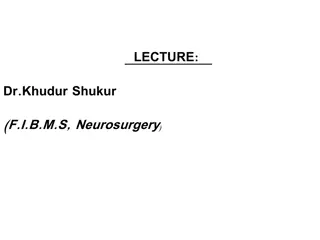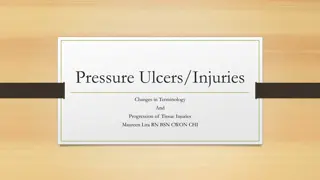Dealing with sports injuries
Anita Turbak, Faculty of Medicine at Rzeszów University, discusses the aims of physiotherapy after sports injury, ways to classify sports injuries, and treatment for soft tissue injuries.
0 views • 15 slides
Spinal injuries
An overview of spinal injuries, including anatomy revision, types of spinal fractures, assessment, management, and common patterns of injuries. It also covers back pain presentation, red flags, differentials, and the structure of vertebrae. The Denis classification of spinal fractures and the most c
3 views • 40 slides
Ergonomics Training Requirements for Minnesota Employers
Employers in Minnesota must comply with statutory training requirements related to ergonomics and safety committees. Training covers topics such as safety committee establishment, ergonomics programs, reporting procedures for injuries, and controls for ergonomic hazards. Non-compliance may result in
0 views • 53 slides
PHYSIOTHERAPY IN KNEE JOINT INJURIES
Explore the anatomy of the knee joint, common knee injuries like meniscus tears and ACL ruptures, and the role of physiotherapy in treatment and rehabilitation. Learn about exercises, gait training, and post-surgical care for knee injuries.
2 views • 12 slides
Comprehensive Guide on Injury, Poisoning, and External Causes
This detailed guide covers various aspects of injuries, poisonings, and other consequences from external causes. It includes information on ICD10 and ICD9 coding, recording and treatment details, vocabulary related to different types of injuries, body parts classification, and code structures for di
2 views • 39 slides
Safe Lifting Techniques to Avoid Ergonomic Injuries: A Comprehensive Guide
Ergonomic injuries are a significant concern in the workplace, with musculoskeletal disorders being a common result. This tutorial explores the risks faced by movers/material handlers and provides insights into safe lifting techniques to prevent injuries. Understanding the importance of ergonomics i
6 views • 21 slides
Needlestick Injuries Prevention and Safety
Prevent needlestick injuries by avoiding unnecessary needle use, using devices with safety features, and implementing safe work practices. Healthcare professionals should report injuries promptly, participate in training, and get vaccinated. Be cautious when handling surgical sharps to prevent injur
5 views • 10 slides
Cold Weather Injuries Prevention Training
This slide deck focuses on preventing, identifying, and treating cold weather injuries. It emphasizes the responsibility of both individuals and commands in preventing cold injuries, highlighting factors contributing to susceptibility and methods for regulation body temperature in cold environments.
3 views • 41 slides
Mesh Chair in Delhi NCR - Bloomsbury Furniture
Bloomsbury Furniture, a chief supplier of ergonomic arrangements, presents the mesh chair in Delhi NCR, rethinking solace and style in office seating. Made with breathable lattice material, this seat guarantees ideal wind current, keeping you cool and agreeable all through your business day. Its erg
0 views • 2 slides
Stylish and ergonomic office furniture -Catalogue
Visit Us Today: \/\/ \/\nStep into the world of Highmoon Office Furniture Catalog \u2013 where style, comfort, and sustainability meet! Browse our range of sleek desks, ergonomic chairs, and innovative storage solutions. Elevate your workspace with top-quality, eco-friendly options designed to in
2 views • 10 slides
Understanding Needle Stick Injuries and Prevention
Needle stick injuries are percutaneous piercing wounds caused by needles or other sharp instruments. They pose significant risks, including exposure to blood-borne diseases. Health-care workers are particularly vulnerable, with millions experiencing such injuries annually. Proper training, safe prac
0 views • 35 slides
Understanding Acute Knee Injuries: Meniscal Tears and Ligament Injuries
Acute knee injuries, such as meniscal tears and ligament injuries, are commonly caused by trauma or twisting motions. Meniscal tears can lead to pain, swelling, and locking of the knee joint, especially in young active individuals. Understanding the anatomy of the knee joint and meniscus, along with
0 views • 56 slides
Understanding Vehicle Collisions: Causes, Types, and Injuries
Vehicle collisions involve various types such as front impacts, side impacts, and rear-end collisions, resulting in different injuries like back and head injuries, neck injuries, soft tissue damage, broken bones, and internal injuries. Understanding the causes and effects of collisions can help prev
0 views • 14 slides
Overview of Burn and Scald Injuries and Classification
Burn injuries from dry heat and scald injuries from hot liquids or steam are common forms of thermal injuries. Other etiological classifications include exposure to chemicals, electrical energy, and radiation. The extent of tissue damage is directly related to temperature and duration. Classificatio
1 views • 31 slides
Ergonomic Tips for Working from Home to Reduce Discomfort
Employees working from home often use laptops leading to discomfort. Follow posture guidelines, use a supportive chair, raise laptop height, and take stretch breaks to reduce ergonomic issues. Short-term modifications like using an ironing board as a keyboard tray or a lap board can also help.
0 views • 8 slides
First Aid Tips for Common Trauma Injuries
Learn how to manage various trauma injuries such as skull fractures, eye injuries, blowout fractures, epistaxis, mouth injuries, soft tissue injuries, open injuries, and penetrating wounds with practical first aid techniques. From treating bleeding and impaled objects to saving dislodged teeth and c
0 views • 16 slides
Preventing Road Traffic Injuries: A Global Perspective
Road traffic injuries are a significant global issue, causing millions of deaths and injuries annually. This report highlights the complexity and dangers of road traffic systems, emphasizing the need for increased awareness and preventive measures at governmental, industrial, and individual levels.
1 views • 27 slides
Ensuring Office Safety: Hazards, Prevention, and Training
Today's offices are prone to various hazards that can lead to injuries and health issues. This presentation covers common office accidents, safety considerations, and preventive measures such as ergonomic practices, fall prevention, and emergency action plans. It emphasizes the importance of control
0 views • 44 slides
Complications of Fractures: Types and Risks
Complications of fractures can be classified as general, local early, and late complications. General complications include shock, embolisms, and fever while local complications involve injuries to nearby tissues and infections. Early local complications can lead to visceral, vascular, nerve injurie
0 views • 29 slides
Understanding Mechanical Injuries: Types, Classification, and General Principles
Mechanical injuries encompass a variety of harms caused to the body, mind, reputation, or property. These injuries can be classified into medical, legal, and medico-legal categories based on factors like intentionality. The types of mechanical injuries range from blunt force trauma to thermal, chemi
0 views • 79 slides
Management of Closed Head Injuries in an Austere Environment Overview
Understanding the pathophysiology of brain injuries, including intracranial pressure changes and specific injuries such as traumatic brain injury (TBI), skull fractures, brain bleeds, and diffuse axonal injuries. It covers classifications, diagnosis, and treatment approaches for mild/concussion, mod
0 views • 27 slides
Understanding Foot Pathologies: Traumatic Injuries and Pressure Injuries
Explore common foot pathologies including traumatic injuries like plantar fasciitis, turf toe, and sprains, as well as pressure injuries such as plantar ulcers and heel spurs. Learn about the causes, symptoms, and treatment options for these conditions.
0 views • 33 slides
Understanding Back Injuries and Prevention Methods
More than 1 million workers suffer from back injuries each year, accounting for a significant portion of workplace injuries. These injuries are not only painful but can also have long-term effects. It is crucial to learn how to avoid injuring or re-injuring your back to prevent pain and avoid potent
1 views • 32 slides
Understanding Pediatric Firearm Injuries and Future Research Directions
Pediatric firearm injuries are a significant public health concern, with thousands of American children affected annually. Research gaps exist in understanding the causes, consequences, and prevention strategies for pediatric firearm injuries. The lack of surveillance data and research funding hinde
0 views • 16 slides
Manual Materials Handling: Basics Concepts in Human Factors Engineering
Understanding manual materials handling (MMH) is crucial in preventing back injuries among workers. MMH involves activities like lifting, pushing, pulling, twisting, carrying, and holding objects. These activities impact workers' health, with MMH being a common cause of occupational fatigue and low
0 views • 38 slides
The Importance of Whole Body Postural Assessment in Occupational Safety and Health
Whole body postural assessments play a crucial role in evaluating ergonomic factors in the workplace to prevent musculoskeletal disorders. Popular observational techniques such as NIOSH lifting equation, RULA, and REBA are commonly used. Ergonomic and job analysis checklists are tailored tools used
0 views • 21 slides
Understanding Ergonomics in Design for Better Worker Health
Ergonomics, the science of designing structures and systems based on human characteristics, plays a crucial role in creating comfortable, safe, and efficient work environments. By considering ergonomic factors in the design of tools, workstations, and systems, workers can complete tasks faster, more
0 views • 15 slides
Guidelines for Implementing Ergonomics in the Workplace - Minnesota OSHA Compliance
Guidelines for implementing ergonomic practices in the workplace according to Minnesota OSHA compliance regulations. The document outlines requirements for assessing and addressing workplace ergonomics, including employee training, risk assessments, and compliance with state statutes. It also detail
0 views • 53 slides
Understanding Injuries to the Cervical and Thoracolumbar Spine
Cervical spine injuries are common, especially in the 15-30 age group, with motor vehicle accidents, falls, and sports being major causes. Male individuals are more prone to injuries. Neurological deficits are associated with specific types of injuries, necessitating prompt imaging for spinal cord i
0 views • 20 slides
Enhancing Office Productivity Choosing the Perfect Desk and Ergonomic Chair
In today's fast-paced work environment, having the right office setup is crucial for productivity and overall well-being. A well-chosen desk and a good ergonomic desk chair can significantly enhance your work efficiency, reduce discomfort, and contri
1 views • 3 slides
Understanding Pressure Ulcers and Tissue Injuries Progression
Pressure ulcers, also known as pressure injuries, are localized damages to the skin and underlying soft tissue usually over bony prominences. The National Pressure Ulcer Advisory Panel changed the terminology in 2016 to classify all stages as injuries, not just ulcers. Stages range from non-blanchab
0 views • 13 slides
Understanding Birth Injuries in Newborns
Birth injuries in newborns can result from various factors during the birthing process, such as soft tissue injuries and head trauma. Soft tissue injuries like facial abrasions and scleral hemorrhage may occur due to causes like dystocia and forceps delivery. Nursing care involves assessing and reas
0 views • 19 slides
Understanding Upper Extremity Injuries and Shoulder Physiology
Upper extremities are prone to various injuries in sports, including sprains, strains, dislocations, fractures, and repetitive motion injuries like arthritis and tendonitis. The shoulder complex involves bones, muscles, tendons, ligaments, and articulations. Joints like the sternoclavicular, acromio
0 views • 63 slides
Understanding Common Sports Injuries by Dr. Ashish Kumar Dubey
Dr. Ashish Kumar Dubey, Assistant Professor in the Department of Physical Education, categorizes common sports injuries into soft tissue injuries, bone injuries, and joint injuries. Soft tissue injuries include sprains, strains, contusions, abrasions, lacerations, and incisions. Sprains are ligament
0 views • 7 slides
Understanding Dentoalveolar Injuries: Causes and Classification
Dentoalveolar injuries refer to trauma affecting the teeth and their supporting structures. These injuries can range from isolated incidents to significant maxillofacial damage. They are classified into categories based on the affected tissues, including hard dental tissues, pulp, periodontal tissue
1 views • 18 slides
Ergonomic Measurement Guide for Proper Posture Setup
Learn how to measure seat height, armrest height, seat pan depth, desk height, screen height, keyboard and mouse height, buttock-popliteal length, popliteal height, knee height, elbow height, and eye height for optimal ergonomic setup. Helpful visuals and tips provided.
0 views • 25 slides
Overview of Peripheral Nerve Injuries and Brachial Plexus Injuries
Explore different types of peripheral nerve injuries including Erb's palsy, Klumpke palsy, isolated axillary nerve injury, and isolated musculocutaneous nerve injury. Learn about the anatomy, causes, motor and sensory exams, and management of these injuries. Understand the myotomes and dermatomes as
0 views • 19 slides
Ergonomic Work Practices for Injury Prevention
Awkward postures and improper load handling can lead to joint strain and muscle overload, increasing the risk of injury. Maintaining neutral spine alignment, proper posture, and distributing tasks effectively can help prevent workplace injuries. Pushing loads rather than pulling whenever possible ca
0 views • 21 slides
Understanding Ergonomics for Construction: Preventing Work-Related Injuries
Ergonomics for construction focuses on fitting workplace conditions to workers' capabilities, aiming to prevent Work-Related Musculoskeletal Disorders (WMSDs). OSHA mandates employers to provide a safe workplace, reducing costs associated with WMSDs and promoting productivity. By recognizing hazards
0 views • 45 slides
Understanding Finger Injuries and Proper Assessment Guidelines
Hand injuries, especially finger injuries, are common in emergency departments. Proper diagnosis and management are crucial to prevent long-term complications. This content covers information on tendon anatomy, nerve innervation, and assessment guidelines for finger injuries.
0 views • 67 slides







































